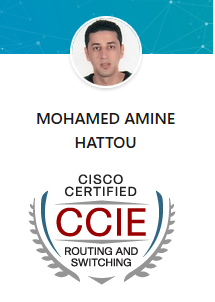





Cette formation vous donne les connaissances pour mettre en œuvre des technologies de réseau d'entreprise, notamment la virtualisation, assurance réseau, la sécurité et l’automatisation elle permet de passer l’examen ENCOR 300 401 qui sera disponible à partir de février 2020 afin d’avoir la certification « Cisco Certified Specialist - Enterprise Core» ou la certif CCNP Entreprise si vous avez déjà passé l’examen ENARSI 300 410
Cette formation vous familiarise avec les technologies principales mise en œuvres dans les réseau d’entreprise , notamment:
CCNA ou équivalent

Amine is a Networking expert he has more then 10 years experiance in ISP Core Network ; he hold serveral Certfications from different Network equipement vendor ; the valuable one is CCIE "Cisco Certified Internetwork Expert".
other cisco certificates :
CCNP RS ; CCNP SP ; CCNA RS/SEC/SP
Cisco certified academy instructor CCAI
Cisco instructor trainer (ITQ)
Juniper certificates:
JNCIA ; JNCIS-ENT, JNCIP-ENT, JNCIS-SP; JNCIP-SP
|
1.0 Architecture |
||
|
1.1 Explain the different design principles used in an enterprise network · 1.1.a Enterprise network design such as Tier 2, Tier 3, and Fabric Capacity planning · 1.1.b High availability techniques such as redundancy, FHRP, and SSO 1.2 Analyze design principles of a WLAN deployment · 1.2.a Wireless deployment models (centralized, distributed, controller-less, controller based, cloud, remote branch) · 1.2.b Location services in a WLAN design 1.3 Differentiate between on-premises and cloud infrastructure deployments 1.4 Explain the working principles of the Cisco SD-WAN solution · 1.4.a SD-WAN control and data planes elements · 1.4.b Traditional WAN and SD-WAN solutions 1.5 Explain the working principles of the Cisco SD-Access solution · 1.5.a SD-Access control and data planes elements · 1.5.b Traditional campus interoperating with SD-Access 1.6 Describe concepts of wired and wireless QoS · 1.6.a QoS components · 1.6.b QoS policy 1.7 Differentiate hardware and software switching mechanisms · 1.7.a Process and CEF · 1.7.b MAC address table and TCAM · 1.7.c FIB vs. RIB |
||
|
2.0 Virtualization |
||
|
2.1 Describe device virtualization technologies · 2.1.a Hypervisor type 1 and 2 · 2.1.b Virtual machine · 2.1.c Virtual switching 2.2 Configure and verify data path virtualization technologies · 2.2.a VRF · 2.2.b GRE and IPsec tunneling 2.3 Describe network virtualization concepts · 2.3.a LISP · 2.3.b VXLAN |
||
|
3.0 Infrastructure |
||
|
3.1 Layer 2 · 3.1.a Troubleshoot static and dynamic 802.1q trunking protocols · 3.1.b Troubleshoot static and dynamic EtherChannels · 3.1.c Configure and verify common Spanning Tree Protocols (RSTP and MST) 3.2 Layer 3 · 3.2.a Compare routing concepts of EIGRP and OSPF (advanced distance vector vs. linked state, load balancing, path selection, path operations, metrics) · 3.2.b Configure and verify simple OSPF environments, including multiple normal areas, summarization, and filtering (neighbor adjacency, point-to-point and broadcast network types, and passive interface) · 3.2.c Configure and verify eBGP between directly connected neighbors (best path selection algorithm and neighbor relationships) 3.3 Wireless · 3.3.a Describe Layer 1 concepts, such as RF power, RSSI, SNR, interference noise, band and channels, and wireless client devices capabilities · 3.3.b Describe AP modes and antenna types · 3.3.c Describe access point discovery and join process (discovery algorithms, WLC selection process) · 3.3.d Describe the main principles and use cases for Layer 2 and Layer 3 roaming · 3.3.e Troubleshoot WLAN configuration and wireless client connectivity issues 3.4 IP Services · 3.4.a Describe Network Time Protocol (NTP) · 3.4.b Configure and verify NAT/PAT · 3.4.c Configure first hop redundancy protocols, such as HSRP and VRRP · 3.4.d Describe multicast protocols, such as PIM and IGMP v2/v3 |
||
|
4.0 Network Assurance |
||
|
4.1 Diagnose network problems using tools such as debugs, conditional debugs, trace route, ping, SNMP, and syslog 4.2 Configure and verify device monitoring using syslog for remote logging 4.3 Configure and verify NetFlow and Flexible NetFlow 4.4 Configure and verify SPAN/RSPAN/ERSPAN 4.5 Configure and verify IPSLA 4.6 Describe Cisco DNA Center workflows to apply network configuration, monitoring, and management 4.7 Configure and verify NETCONF and RESTCONF |
||
|
5.0 Security |
||
|
5.1 Configure and verify device access control · 5.1.a Lines and password protection · 5.1.b Authentication and authorization using AAA 5.2 Configure and verify infrastructure security features · 5.2.a ACLs · 5.2.b CoPP 5.3 Describe REST API security 5.4 Configure and verify wireless security features · 5.4.a EAP · 5.4.b WebAuth · 5.4.c PSK 5.5 Describe the components of network security design · 5.5.a Threat defense · 5.5.b Endpoint security · 5.5.c Next-generation firewall · 5.5.d TrustSec, MACsec · 5.5.e Network access control with 802.1X, MAB, and WebAuth |
||
|
6.0 Automation |
||
|
6.1 Interpret basic Python components and scripts 6.2 Construct valid JSON encoded file 6.3 Describe the high-level principles and benefits of a data modeling language, such as YANG 6.4 Describe APIs for Cisco DNA Center and vManage 6.5 Interpret REST API response codes and results in payload using Cisco DNA Center and RESTCONF 6.6 Construct EEM applet to automate configuration, troubleshooting, or data collection 6.7 Compare agent vs. agentless orchestration tools, such as Chef, Puppet, Ansible, and SaltStack |
||